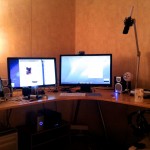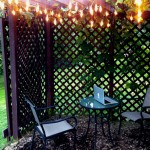Moving into a new house has meant more space, and a chance to separate my various modes of work a little. I’m more efficient at switching modes (working, writing, playing, etc.) if I can switch spaces. Now, I have three work spaces.
 First, a “command central” for writing music, coding and fiddling. This has my Mac Pro with a dual-monitor setup, studio monitors, my Oxygen 49 and several mics, my acoustic, electric and bass guitars on a rack to the left and a lot of drawers for cables and additional gizmos (the Mac Pro there also runs the home automation and media servers). I can and will do my day job here, but this is the one I’m allowed to be chaotic at. It’s not that I’m not creative in a sterile (read minimal) environment, but the byproduct of my most creative moments is, well, chaotic surroundings. I’ve decided to just let that happen as it always has, but designate “concentration” spaces for my other two modes.
First, a “command central” for writing music, coding and fiddling. This has my Mac Pro with a dual-monitor setup, studio monitors, my Oxygen 49 and several mics, my acoustic, electric and bass guitars on a rack to the left and a lot of drawers for cables and additional gizmos (the Mac Pro there also runs the home automation and media servers). I can and will do my day job here, but this is the one I’m allowed to be chaotic at. It’s not that I’m not creative in a sterile (read minimal) environment, but the byproduct of my most creative moments is, well, chaotic surroundings. I’ve decided to just let that happen as it always has, but designate “concentration” spaces for my other two modes.
 On the other side of my office is a nook with a small desk which has a keyboard drawer with a Bluetooth keyboard, Magic Mouse and a large Moleskine. There’s also a small lightbox. My MacBook Air sits in front of the lightbox, which is angled toward the wall, and I get a nice, empty desk with a comforting glow around my work area. This desk is for writing and nothing else. My brain is easily trained to accept certain reactions to certain spaces (e.g. bed for sleeping), so I think this will work well.
On the other side of my office is a nook with a small desk which has a keyboard drawer with a Bluetooth keyboard, Magic Mouse and a large Moleskine. There’s also a small lightbox. My MacBook Air sits in front of the lightbox, which is angled toward the wall, and I get a nice, empty desk with a comforting glow around my work area. This desk is for writing and nothing else. My brain is easily trained to accept certain reactions to certain spaces (e.g. bed for sleeping), so I think this will work well.
 Lastly, the work-only space. On nice days in the warm 1/3 of the Minnesota year, I have an amazing outdoor office. It’s a small table in a small walled garden facing the heavily wooded area on the slope of the bluff. There are warm, yellow rope lights across the top of the area and the gate slides open to the back yard and woods. It’s pretty close to my definition of perfect. In the cold months, I have an extra space near my main office that I’ll be converting, but I won’t have to worry about that for another month.
Lastly, the work-only space. On nice days in the warm 1/3 of the Minnesota year, I have an amazing outdoor office. It’s a small table in a small walled garden facing the heavily wooded area on the slope of the bluff. There are warm, yellow rope lights across the top of the area and the gate slides open to the back yard and woods. It’s pretty close to my definition of perfect. In the cold months, I have an extra space near my main office that I’ll be converting, but I won’t have to worry about that for another month.
I don’t really believe in being distracted. I believe that I procrastinate and create my own distractions, but my workspace rarely has anything to do with it. I have the job flexibility to be able to accept that my brain isn’t in a work mode at almost any time, take 15 minutes to read my RSS feeds or hack around, then get back to it. Once I’m in work mode, I get as obsessed with that as I do with my more creative pursuits. Of course, my job requires creativity, too, and I really couldn’t hold a job that didn’t. The minimalism in the auxiliary workspaces is more to help me keep my clutter contained than to prevent distraction. I think it’s going to work out great!



